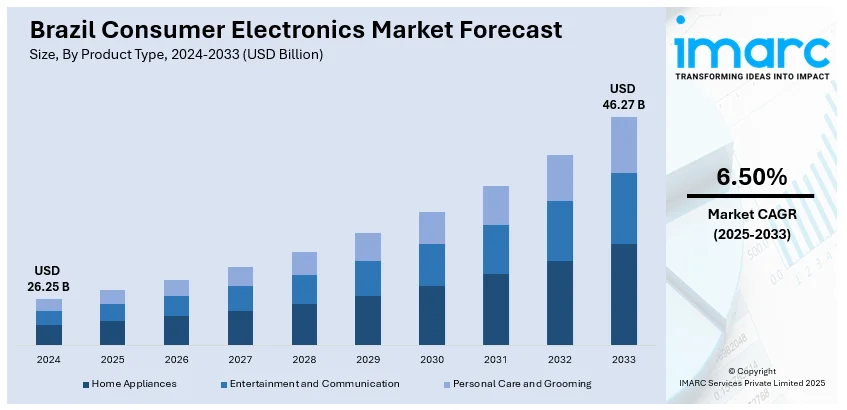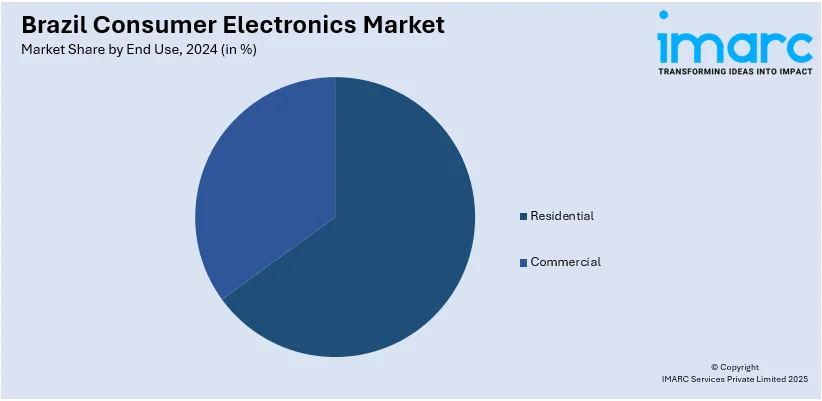
Brazil Consumer Electronics Market Size, Share, Trends and Forecast by Product Type, Category, End Use, Distribution Channel and Region, 2025-2033
Brazil Consumer Electronics Market Overview:
The Brazil consumer electronics market size reached USD 26.25 Billion in 2024. Looking forward, IMARC Group expects the market to reach USD 46.27 Billion by 2033, exhibiting a growth rate (CAGR) of 6.50% during 2025-2033. The market is primarily driven by the increasing disposable incomes, widespread adoption of smartphones, increasing investment in IT infrastructure, and expanding e-commerce platforms, which are further evolving consumer preferences for connected and smart devices across Brazil.
|
Report Attribute
|
Key Statistics
|
|---|---|
|
Base Year
|
2024 |
|
Forecast Years
|
2025-2033
|
|
Historical Years
|
2019-2024
|
| Market Size in 2024 | USD 26.25 Billion |
| Market Forecast in 2033 | USD 46.27 Billion |
| Market Growth Rate (2025-2033) | 6.50% |
Brazil Consumer Electronics Market Trends:
Increasing Investment in IT Infrastructure
Increasing investment in IT infrastructure is playing a crucial role in shaping Brazil's consumer electronics market. According to the 2023 Brazil Predictions study by the International Data Corporation (IDC) and a report from the Brazilian Association of Software Companies (ABES), the Brazilian Information Technology (IT) market reached a value of US$ 45.2 Billion in 2022. Moreover, the software market propelled by advancements in security, data management, artificial intelligence (AI), and customer experience (CX) solutions, was anticipated to expand by 15.1% in 2023. Software as a Service (SaaS) was expected to constitute half of the software sales, with a projected growth of 27.6% in the same year. Additionally, general IT services were forecasted to see a growth of 6.7% in 2023, particularly in areas such as application management, consulting, and systems integration. As the investment increases in IT systems and networks by businesses and governments, consumer electronics needs related to it are influencing the market growth. Moreover, the increasing number of computers, networking devices, and storage solutions that are implemented need to comply with the requirement of supporting more robust IT frameworks. As such, this is important in the context of what is happening in the industrial initiatives of digital transformation. Furthermore, companies are integrating newer technologies in their efforts to optimize the management of data, security arrangements, and operational efficiencies; such innovations have resulted in the need for advanced electronics that meet these new standards.

Rising Household Income
The increase in per capita household income in Brazil is significantly influencing the consumer electronics market. As the household disposable income increases, there is a greater propensity to allocate funds to consumer electronics. It creates an economic boost for the consumer’s lifestyle and connectivity as consumers upgrade from their existing product line and adopt higher-end products. According to reports from the Brazilian Institute of Geography and Statistics (IBGE), the annual continuous national household sample survey reported that in 2023 the per capita household income for Brazil and its Federation Units stood at R$ 1,893, while the lowest was reported in Maranhao at R$ 945, while the highest is that of the Federal District at R$ 3,357. Besides, the additional disposable income in the Brazilian household is pushing consumers to spend more on high-end appliances such as smartphones, smart TVs, and other connected electronic devices owing to better features and connectivity. Hence, household income growth directly fuels the expansion and dynamism of Brazil's consumer electronics market.
Expansion of E-Commerce and Digital Retail Platforms
The quick growth of e-commerce and online retail platforms is revolutionizing Brazil's consumer electronics industry. As internet penetration and mobile access improve, consumers are gravitating towards online shopping for convenience, price competitiveness, and greater product choice. Large retailers and marketplaces are building their digital capabilities, using AI-based recommendations, targeted marketing, and frictionless payment options to enhance customer experiences. Second, the use of omnichannel strategies, coupled with online-offline sales incorporation, is rationalizing the consumer buying process. Cross-border ecommerce is also being popularized to facilitate access to international brands as well as specialist products. And with digital modes of payment in the form of fintech service and digital wallet becoming more easily accepted, consumer electronics ecommerce growth is being influenced by e-commerce further, influencing consumer buying trends and market openings for local brands as well as global brands further.
Brazil Consumer Electronics Market Segmentation:
IMARC Group provides an analysis of the key trends in each segment of the market, along with forecasts at the region level for 2025-2033. Our report has categorized the market based on product type, category, end use, and distribution channel.
Product Type Insights:
- Home Appliances
- Large Electronics Appliances
- Refrigerators
- Air Conditioners
- Washing Machines
- Air Purifiers
- Others
- Large Electronics Appliances
-
- Small Electronic Appliances
- Microwave Ovens
- Food Processors
- Electric Fans
- Vacuum Cleaners
- Others
- Small Electronic Appliances
- Entertainment and Communication
- Televisions
- Mobiles and Smartphones
- Laptops and Computers
- Audio and Video Players
- Cameras
- Speakers
- Video Games
- Others
- Personal Care and Grooming
- Wearables
- Smartwatches
- Headphones
- Earphones and Earbuds
- Others
- Hair Care Devices
- Hair Straightener
- Hair Curler
- Hair Dryer
- Others
- Beauty Devices
- Face/Skin Care Devices
- Hair Removal Devices
- Nail Care Devices
- Others
- Others
- Wearables
The report has provided a detailed breakup and analysis of the market based on the product type. This includes home appliances (large electronics appliances {refrigerators, air conditioners, washing machines, air purifiers and others}, small electronic appliances {microwave ovens, food processors, electric fans, vacuum cleaners, and others}), entertainment and communication (televisions, mobiles and smartphones, laptops and computers, audio and video players, cameras, speakers, video games, others), personal care and grooming (wearables (smartwatches, headphones, earphones and earbuds, others), hair care devices (hair straightener, hair curler, hair dryer, others), beauty devices (face/skin care devices, hair removal devices, nail care devices, others), others)
Category Insights:
- Smart
- Conventional
A detailed breakup and analysis of the market based on the category have also been provided in the report. This includes smart, and conventional.
End Use Insights:

- Residential
- Commercial
- Hotels and Restaurants
- Cafes
- Hospitals
- Corporate Offices
- Others
The report has provided a detailed breakup and analysis of the market based on the end use. This includes residential, commercial (hotels and restaurants, cafes, hospitals, corporate offices, others).
Distribution Channel Insights:
- B2B
- B2C
- Online
- Company-owned Websites
- E-commerce Websites
- Offline
- Supermarkets/Hypermarkets
- Specialty Stores
- Other Retail Stores
- Online
A detailed breakup and analysis of the market based on the distribution channel have also been provided in the report. This includes B2B, and B2C (online (Company-owned Websites, E-commerce Websites), offline (Supermarkets/Hypermarkets, Specialty Stores, Other Retail Stores).
Regional Insights:
- Southeast
- South
- Northeast
- North
- Central-West
The report has also provided a comprehensive analysis of all the major regional markets, which include Southeast, South, Northeast, North, and Central-West.
Competitive Landscape:
The market research report has also provided a comprehensive analysis of the competitive landscape. Competitive analysis such as market structure, key player positioning, top winning strategies, competitive dashboard, and company evaluation quadrant has been covered in the report. Also, detailed profiles of all major companies have been provided.
Brazil Consumer Electronics Market News:
- In November 2024, OPPO expanded its presence in Brazil, launching the A40 smartphone. Strengthening partnerships with Magazine Luiza and Claro, the company aims to sell in 1,000+ stores by 2025, ensuring wide availability and after-sales support. OPPO also plans 20 service centers across Brazil.
- In September 2024, Foxconn began assembling iPhone 16 units in Brazil as the series launched worldwide. According to MacMagazine, Apple is broadening its production footprint beyond China and India. This is the first instance of an Apple model being manufactured in Latin America at the time of its initial release. This strategy allows Apple to navigate Brazil’s high import tariffs, enhance sales, and reduce the risk of supply chain disruptions stemming from geopolitical issues.
- In March 2024, Positivo Tecnologia acquired Algar TI Consultoria S.A. for R$235 million. The deal enhances its presence in cloud computing, AI, and cybersecurity, doubles its workforce, and strengthens its international footprint across Argentina, Colombia, and Mexico.
Brazil Consumer Electronics Market Report Coverage:
| Report Features | Details |
|---|---|
| Base Year of the Analysis | 2024 |
| Historical Period | 2019-2024 |
| Forecast Period | 2025-2033 |
| Units | Billion USD |
| Scope of the Report |
Exploration of Historical Trends and Market Outlook, Industry Catalysts and Challenges, Segment-Wise Historical and Future Market Assessment:
|
| Product Types Covered |
|
| Categories Covered | Smart, Conventional |
| End Uses Covered |
|
| Distribution Channels Covered |
|
| Regions Covered | Southeast, South, Northeast, North, Central-West |
| Customization Scope | 10% Free Customization |
| Post-Sale Analyst Support | 10-12 Weeks |
| Delivery Format | PDF and Excel through Email (We can also provide the editable version of the report in PPT/Word format on special request) |
Key Questions Answered in This Report:
- How has the Brazil consumer electronics market performed so far and how will it perform in the coming years?
- What is the breakup of the Brazil consumer electronics market on the basis of product type?
- What is the breakup of the Brazil consumer electronics market on the basis of category?
- What is the breakup of the Brazil consumer electronics market on the basis of end use?
- What is the breakup of the Brazil consumer electronics market on the basis of distribution channel?
- What is the breakup of the Brazil consumer electronics market on the basis of region?
- What are the various stages in the value chain of the Brazil consumer electronics market?
- What are the key driving factors and challenges in the Brazil consumer electronics?
- What is the structure of the Brazil consumer electronics market and who are the key players?
- What is the degree of competition in the Brazil consumer electronics market?
Key Benefits for Stakeholders:
- IMARC’s industry report offers a comprehensive quantitative analysis of various market segments, historical and current market trends, market forecasts, and dynamics of the Brazil consumer electronics market from 2019-2033.
- The research report provides the latest information on the market drivers, challenges, and opportunities in the Brazil consumer electronics market.
- Porter's five forces analysis assist stakeholders in assessing the impact of new entrants, competitive rivalry, supplier power, buyer power, and the threat of substitution. It helps stakeholders to analyze the level of competition within the Brazil consumer electronics industry and its attractiveness.
- Competitive landscape allows stakeholders to understand their competitive environment and provides an insight into the current positions of key players in the market.
Need more help?
- Speak to our experienced analysts for insights on the current market scenarios.
- Include additional segments and countries to customize the report as per your requirement.
- Gain an unparalleled competitive advantage in your domain by understanding how to utilize the report and positively impacting your operations and revenue.
- For further assistance, please connect with our analysts.
 Inquire Before Buying
Inquire Before Buying
 Speak to an Analyst
Speak to an Analyst
 Request Brochure
Request Brochure
 Request Customization
Request Customization




.webp)




.webp)












